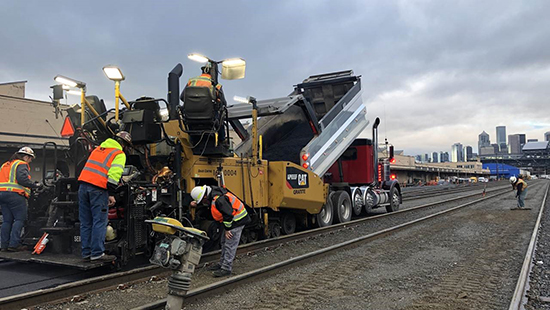|
Subscribe / Renew |
|
|
Contact Us |
|
| ► Subscribe to our Free Weekly Newsletter | |
| home | Welcome, sign in or click here to subscribe. | login |
Construction
| |
 |
May 20, 2022
General Contractor, Highway/Civil More Than 500,000 Worker Hours

Granite
One of the most dangerous risks Granite encounters on its heavy-civil transportation projects is working alongside high-speed multi-lane interstates at night. Most drivers are cautious as they travel through construction zones, but occasionally, Granite cannot account for irresponsible or reckless driving. Unfortunately, across the company, Granite has experienced many incidents where third-party motorists have crashed into its construction sites and have severely injured employees.
To promote safety for Granite crews, the company implemented several strategies to maintain a positive separation between crews and multi-modal traffic. Strategies implemented in recent years include the involvement of Washington State Patrol and creating smart workzones (with smart queues). Granite also recognized that crews on the back of truck-mounted attenuators (TMA), or vehicles it set traffic channelizing devices from, did not have much of a safety barrier to protect them from third-party motorist incidents.
To reduce this hazard, Granite identified three options: put everyone on the TMA in a seat and seatbelt; install a guardrail around the TMA deck; and install a fall restraint system. Given the nature of work requiring employees to build barrels while on the deck and deliver them to another employee on the side of the TMA to set on the roadway, the first option was not feasible. The second option (installing a guardrail) would require crews to maneuver barrels around the guardrail, increasing ergonomic hazard substantially. The third option (installing a fall restraint system) proved to be the most efficient and logical choice to protect Granite employees.
Within the past year, Granite’s Pacific Northwest Region outfitted seven TMA vehicles with a fall restraint system, which consists of anchors and anchor points, an engineered horizontal lifeline, and multiple lanyards of different lengths to ensure employees of all different sizes cannot reach the edge of the TMA where the fall hazard exists. There were, however, some challenges to implement this innovation. First, there was no industry precedence for installing a horizontal lifeline on a mobile vehicle. Second, a DOSH directive that referenced setting channelizing devices from mobile vehicles was produced in May 2021 that created a sense of urgency to get this system complete as fast as possible so Granite could resume work with its TMAs. Lastly, this innovation involved extensive coordination to retrofit the TMAs between four departments (safety, management, traffic control, and equipment) and a third-party welding firm.
Though relatively uncommon and challenging to implement, the horizontal lifeline system provides the barrier of safety needed for Granite crews to work alongside high-speed, and often unpredictable, traffic. Granite recognized the hazard and is responsible for mitigating the risk in every way possible to ensure its employees return safely to their loved ones at the end of the day.
Other Stories:
- Grand Award: Construction
Highway/Transportation $15 Million To $50 Million - Heavy/Industrial under $5 Million
- Construction Manager Less Than 100,000 Worker Hours
- General Contractor, Highway/Civil Less Than 500,000 Worker Hours
- Specialty Contractor Under 100,000 Worker Hours
- Specialty Contractor 100,000 to 500,000 Worker Hours
- Specialty Contractor 500,000 to 1 Million Worker Hours
- Specialty Contractor More Than 2 Million Worker Hours
- General Contractor Under 150,000 Worker Hours
- General Contractor 150,000 to 250,000 Worker Hours
- General Contractor 250,000 to 500,000 Worker Hours
- General Contractor 1 Million to 1.5 Million Worker Hours
- General Contractor More Than 1.5 Million Worker Hours
- Rising Star Award
- Brian Salsgiver Safety Professional Of The Year
- Project Manager Of The Year
- Highway/Transportation over $50 Million
- Highway/Transportation $5 Million to $15 Million
- Grand Award: Safety
Construction Manager more than 250K hours - Excellence In Innovation
- Public Building $2 Million to $5 Million
- Public Building $5 Million to $20 Million
- AGC/Moss Adams Community Service Award
- Champion Of Diversity Award
- Public Building $20 Million to $50 Million
- Public Building more than $100 Million
- Private Building $5 Million to $20 Million
- Private Building $50 Million to $100 Million
- Private Building $20 Million to $50 Million
- Private Building more than $100 Million
- Tenant Improvement less than $5 Million
- Tenant Improvement more than $5 Million
- Highway/Transportation under $5 Million
- Superintendent Of The Year


